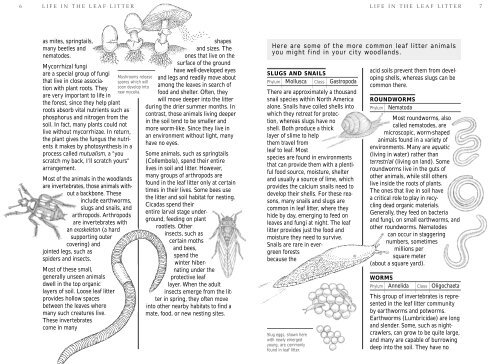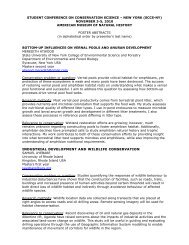Life In The Leaf Litter - American Museum of Natural History
Life In The Leaf Litter - American Museum of Natural History
Life In The Leaf Litter - American Museum of Natural History
You also want an ePaper? Increase the reach of your titles
YUMPU automatically turns print PDFs into web optimized ePapers that Google loves.
6 LIFE IN THE LEAF LITTER<br />
as mites, springtails,<br />
many beetles and<br />
nematodes.<br />
Mycorrhizal fungi<br />
are a special group <strong>of</strong> fungi<br />
that live in close association<br />
with plant roots. <strong>The</strong>y<br />
are very important to life in<br />
the forest, since they help plant<br />
roots absorb vital nutrients such as<br />
phosphorus and nitrogen from the<br />
soil. <strong>In</strong> fact, many plants could not<br />
live without mycorrhizae. <strong>In</strong> return,<br />
the plant gives the fungus the nutrients<br />
it makes by photosynthesis in a<br />
process called mutualism, a “you<br />
scratch my back, I’ll scratch yours”<br />
arrangement.<br />
Mushrooms release<br />
spores which will<br />
soon develop into<br />
new mycelia.<br />
Most <strong>of</strong> the animals in the woodlands<br />
are invertebrates, those animals without<br />
a backbone. <strong>The</strong>se<br />
include earthworms,<br />
slugs and snails, and<br />
arthropods. Arthropods<br />
are invertebrates with<br />
an exoskeleton (a hard<br />
supporting outer<br />
covering) and<br />
jointed legs, such as<br />
spiders and insects.<br />
Most <strong>of</strong> these small,<br />
generally unseen animals<br />
dwell in the top organic<br />
layers <strong>of</strong> soil. Loose leaf litter<br />
provides hollow spaces<br />
between the leaves where<br />
many such creatures live.<br />
<strong>The</strong>se invertebrates<br />
come in many<br />
shapes<br />
and sizes. <strong>The</strong><br />
ones that live on the<br />
surface <strong>of</strong> the ground<br />
have well-developed eyes<br />
and legs and readily move about<br />
among the leaves in search <strong>of</strong><br />
food and shelter. Often, they<br />
will move deeper into the litter<br />
during the drier summer months. <strong>In</strong><br />
contrast, those animals living deeper<br />
in the soil tend to be smaller and<br />
more worm-like. Since they live in<br />
an environment without light, many<br />
have no eyes.<br />
Some animals, such as springtails<br />
(Collembola), spend their entire<br />
lives in soil and litter. However,<br />
many groups <strong>of</strong> arthropods are<br />
found in the leaf litter only at certain<br />
times in their lives. Some bees use<br />
the litter and soil habitat for nesting.<br />
Cicadas spend their<br />
entire larval stage underground,<br />
feeding on plant<br />
rootlets. Other<br />
insects, such as<br />
certain moths<br />
and bees,<br />
spend the<br />
winter hibernating<br />
under the<br />
protective leaf<br />
layer. When the adult<br />
insects emerge from the litter<br />
in spring, they <strong>of</strong>ten move<br />
into other nearby habitats to find a<br />
mate, food, or new nesting sites.<br />
SLUGS AND SNAILS<br />
Phylum | Mollusca | Class | Gastropoda<br />
<strong>The</strong>re are approximately a thousand<br />
snail species within North America<br />
alone. Snails have coiled shells into<br />
which they retreat for protection,<br />
whereas slugs have no<br />
shell. Both produce a thick<br />
layer <strong>of</strong> slime to help<br />
them travel from<br />
leaf to leaf. Most<br />
species are found in environments<br />
that can provide them with a plentiful<br />
food source, moisture, shelter<br />
and usually a source <strong>of</strong> lime, which<br />
provides the calcium snails need to<br />
develop their shells. For these reasons,<br />
many snails and slugs are<br />
common in leaf litter, where they<br />
hide by day, emerging to feed on<br />
leaves and fungi at night. <strong>The</strong> leaf<br />
litter provides just the food and<br />
moisture they need to survive.<br />
Snails are rare in evergreen<br />
forests<br />
because the<br />
LIFE IN THE LEAF LITTER 7<br />
Here are some <strong>of</strong> the more common leaf litter animals<br />
you might find in your city woodlands.<br />
Slug eggs, shown here<br />
with newly emerged<br />
young, are commonly<br />
found in leaf litter.<br />
acid soils prevent them from developing<br />
shells, whereas slugs can be<br />
common there.<br />
ROUNDWORMS<br />
Phylum | Nematoda<br />
Most roundworms, also<br />
called nematodes, are<br />
microscopic, worm-shaped<br />
animals found in a variety <strong>of</strong><br />
environments. Many are aquatic<br />
(living in water) rather than<br />
terrestrial (living on land). Some<br />
roundworms live in the guts <strong>of</strong><br />
other animals, while still others<br />
live inside the roots <strong>of</strong> plants.<br />
<strong>The</strong> ones that live in soil have<br />
a critical role to play in recycling<br />
dead organic materials.<br />
Generally, they feed on bacteria<br />
and fungi, on small earthworms, and<br />
other roundworms. Nematodes<br />
can occur in staggering<br />
numbers, sometimes<br />
millions per<br />
square meter<br />
(about a square yard).<br />
WORMS<br />
Phylum | Annelida | Class | Oligochaeta<br />
This group <strong>of</strong> invertebrates is represented<br />
in the leaf litter community<br />
by earthworms and potworms.<br />
Earthworms (Lumbricidae) are long<br />
and slender. Some, such as nightcrawlers,<br />
can grow to be quite large,<br />
and many are capable <strong>of</strong> burrowing<br />
deep into the soil. <strong>The</strong>y have no

















